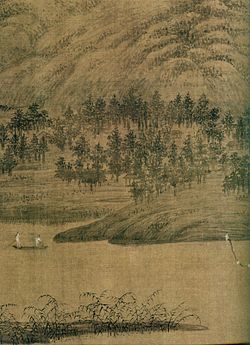
Back دونج يوان ARZ Donq Yuan Azerbaijani دۆنگ یوان CKB Tung Jüan Czech Dong Yuan German Dong Yuan Spanish Dong Yuan Finnish Dong Yuan French 董源 GAN Dŏng Yuán Galician
Dong Yuan | |
|---|---|
 Detail from Xiao and Xiang Rivers, permanent collection at the Palace Museum. This painting is often considered to be one of Dong Yuan's greatest masterpieces, and it "illustrates the revolutionary impressionism" he had achieved by "means of broken ink washes and the elimination of the outline."[1] | |
| Born | c. 932 |
| Died | c. 962 |
| Nationality | Chinese |
| Known for | Painting |
| Movement | Southern Tang, Jiangnan style |
Dong Yuan (Chinese: 董源; pinyin: Dǒng Yuán; Wade–Giles: Tung Yüan, Gan: dung3 ngion4; c. 934 – c. 962) was a Chinese painter.
He was born in Zhongling (钟陵; present-day Jinxian County, Jiangxi Province).[2] Dong Yuan was active in the Southern Tang Kingdom of the Five Dynasties and Ten Kingdoms period. He was from Nanjing, which was a center for culture and the arts.
He was known for both figure and landscape paintings, and exemplified the elegant style which would become the standard for brush painting in China for the next nine centuries. He and his pupil Juran (巨然) were the founders of the Southern style of landscape painting, known as the Jiangnan Landscape style. Together with Jing Hao and Guan Tong of the Northern style they constituted the four seminal painters of that time.
As with many artists in China, his profession was as an official, here he studied the existing styles of Li Sixun and Wang Wei. However, he added to these masters' techniques; he included more sophisticated perspective.
- ^ Sullivan, Michael (1999). The Arts of China. University of California Press. p. 183. ISBN 0-520-21877-9.
- ^ Cihai: Page 599.
© MMXXIII Rich X Search. We shall prevail. All rights reserved. Rich X Search